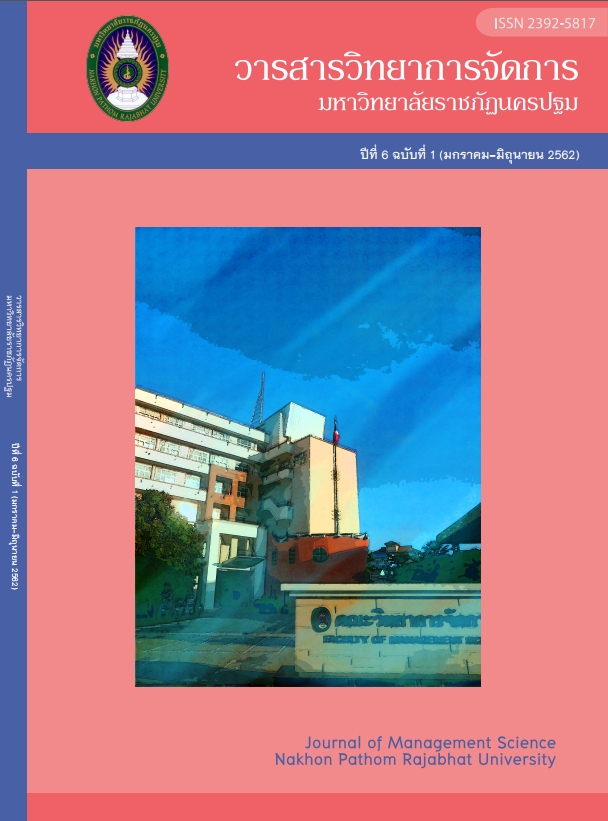Guidelines for development of marketing mix of natural attractions in Kanchanaburi Province
Main Article Content
Abstract
This research aimed to: 1) compare the level of marketing mix of natural attractions in Kanchanaburi Province as classified by personal factors; 2) study the relationship between personal factors and natural tourism behavior in Kanchanaburi Province; and 3) study the guidelines for development of marketing mix of natural attractions in Kanchanaburi Province. The research sample was divided into 2 groups. The first group of questionnaire respondents consisted of 400 tourists who visited natural attractions in Kanchanaburi derived by quota sampling. The second group of interviewees consisted of 4 natural park officers at natural attractions in Kanchanaburi Province derived by purposive sampling. The research instruments were a questionnaire and an interview form constructed by the researcher, with the content validity between 0.66 and 1.00 and the reliability of 0.78 - 0.90. Data were analyzed with percentage, mean, standard deviation, t-test, one-way ANOVA, chi-square and content analysis.
The research results revealed as follows:
1. The tourists with differences in gender, age and status had a different opinion on the marketing mix of natural attractions in Kanchanaburi Province with significant difference at .05 level.
2. The tourists’ personal factor in aspects of educational level, occupation, monthly income, status, and domicile had relationship with tourism behavior in aspects of travel purpose, travel method, number of companions, number of travels, travel period, relationship between companions, and travel expense with significant difference at .05 level. Additionally, the tourists’ gender showed relationship with tourism behavior in aspects of number of companions, number of travels, travel period, and travel expense with significant difference at .05 level. However, it showed no relationship with travel purpose, travel method, and relationship between companions.
3. The guidelines for development of marketing mix strategies of natural attractions in Kanchanaburi Province on the service providers’ views were: servicing by focusing on tourists’ satisfaction; setting fair price in accordance with experience value; increasing a variety of distribution channels; advertising tourist attractions through online media to ensure information accessibility; training tourism personnel about knowledge and understanding of natural attractions; and instilling awareness in service mindedness.
Article history : Received 11 December 2018
Revised 14 April 2019
Accepted 17 April 2019
SIMILARITY INDEX = 3.13
Article Details
The views and opinions of the article appearing in this journal are those of the author. It is not considered a view and responsibility of the editorial staff.
References
การท่องเที่ยวแห่งประเทศไทย. (2561). สถานที่ท่องเที่ยว. [ออนไลน์]. ค้นเมื่อ 4 พฤศจิกายน 2561, จาก https://www. kanchanaburi-info.com/th/sitemap.html.
ฉันทัช วรรณถนอม. (2552). การวางแผนและการจัดนำเที่ยว. กรุงเทพฯ : บริษัท วิรัตน์เอ็ดดูเคชั่น จำกัด.
ฉันท์ชนิต เกตุน้อย. (2561). ความสัมพันธ์ระหว่างส่วนประสมทางการตลาด 7P’s และการส่งเสริมการท่องเที่ยวเชิงประวัติศาสตร์ของพระราชวังจันทน์ จังหวัดพิษณุโลก. วารสารวิชาการ สถาบันการพลศึกษา. 10 (2): 17-28.
นวพรรษ พันธัง. (2560). ปัจจัยส่วนประสมการตลาดบริการและพฤติกรรมการท่องเที่ยวของนักท่องเที่ยวในอำเภอหัวหิน
จังหวัดประจวบคีรีขันธ์. สารนิพนธ์ปริญญาบริหารธุรกิจมหาบัณฑิต บัณฑิตวิทยาลัย มหาวิทยาลัยธุรกิจบัณฑิตย์.
บุญเลิศ จิตตั้งวัฒนา. (2555). พฤติกรรมนักท่องเที่ยว .นนทบุรี : สำนักพิมพ์เฟริ์นข้าหลวง.
เพ็ญนภา เพ็งประไพ. (2559). ปัจจัยส่วนประสมทางการตลาดที่มีอิทธิพลต่อความต้องการของนักท่องเที่ยวชาวไทยและต่างชาติในกิจกรรมการท่องเที่ยวเชิงสังคมและวัฒนธรรมของเกาะพะงัน จังหวัดสุราษฎร์ธานี. การค้นคว้าอิสระปริญญาศิลปศาสตรมหาบัณฑิต.
สาขาวิชาการจัดการอุตสาหกรรมการบริการและการท่องเที่ยว มหาวิทยาลัยกรุงเทพ.
มณีรัตน์ สุขเกษม. (2559). บทปริทัศน์หนังสือ การท่องเที่ยวอย่างยั่งยืน และการท่องเที่ยวเชิงนิเวศ: การศึกษาและมุมมองใหม่. วารสารปาริชาต. 29 (2): 235-248.
ศุภลักษณ์ อัครางกูร. (2551). พฤติกรรมนักท่องเที่ยว (พิมพ์ครั้งที่ 4). ขอนแก่น:โรงพิมพ์คลังนานาวิทยา.
สำนักงานพัฒนาการท่องเที่ยว. (2561). ความหมายของการท่องเที่ยว. [ออนไลน์]. ค้นเมื่อ 3 ธันวาคม 2561, จาก https://tourismatbuu.wordpress.com.
สำนักงานสภาพัฒนาการเศรษฐกิจและสังคมแห่งชาติ. (2560). แผนพัฒนาเศรษฐกิจและสังคมแห่งชาติฉบับที่ 12 (พ.ศ. 2560 - 2564). กรุงเทพมหานคร:สำนักงานสภาพัฒนาการเศรษฐกิจและสังคมแห่งชาติ.
สำนักงานสถิติจังหวัดกาญจนบุรี (2559). นักท่องเที่ยวที่เดินทางมาท่องเที่ยวในจังหวัดกาญจนบุรี.[ออนไลน์]. ค้นเมื่อ 10 ตุลาคม 2560. จาก https://kanchanaburi.nso.go.th/index.php.
Cronbach, L. J. (1974). Essentials of Psychological Testing (3rd ed.). New York: Harper and Row.
Kotler, P. (2000). Marketing Management. The Millennium edition. New Jersey:Prentic – Hall.
Krejcie, R. V. & Morgan, D. W. (1970). Determining sample size for research activities. Educational & Psychological Measurement, 30 (3), 607-610.
World Tourism Organization. (2018). Style and type of tourism. Retrieved April 16, 2018, from www.unwto.org

